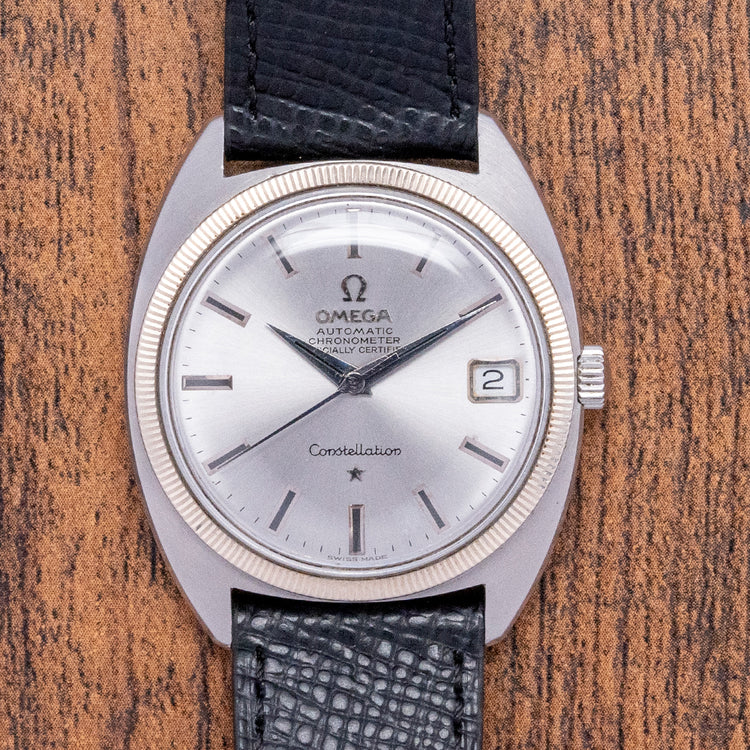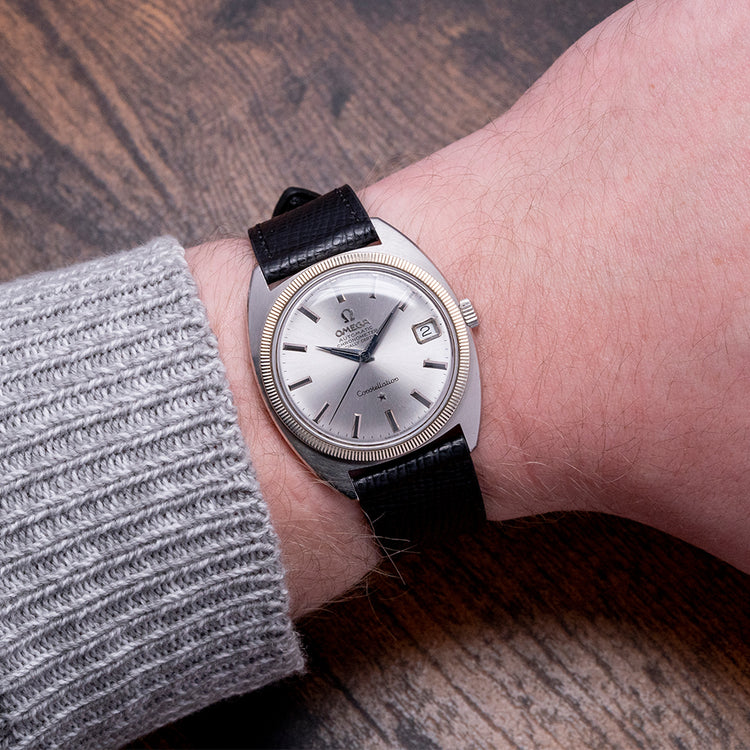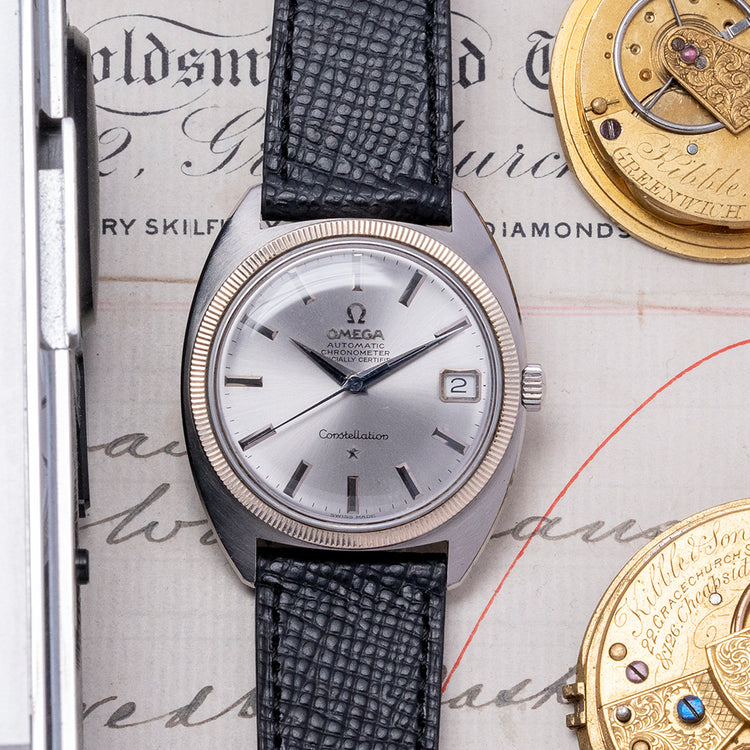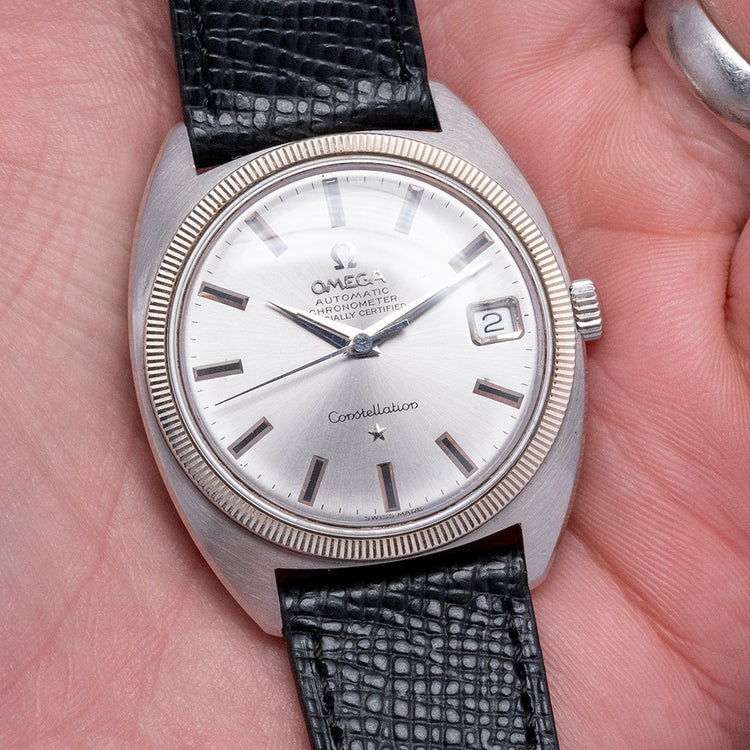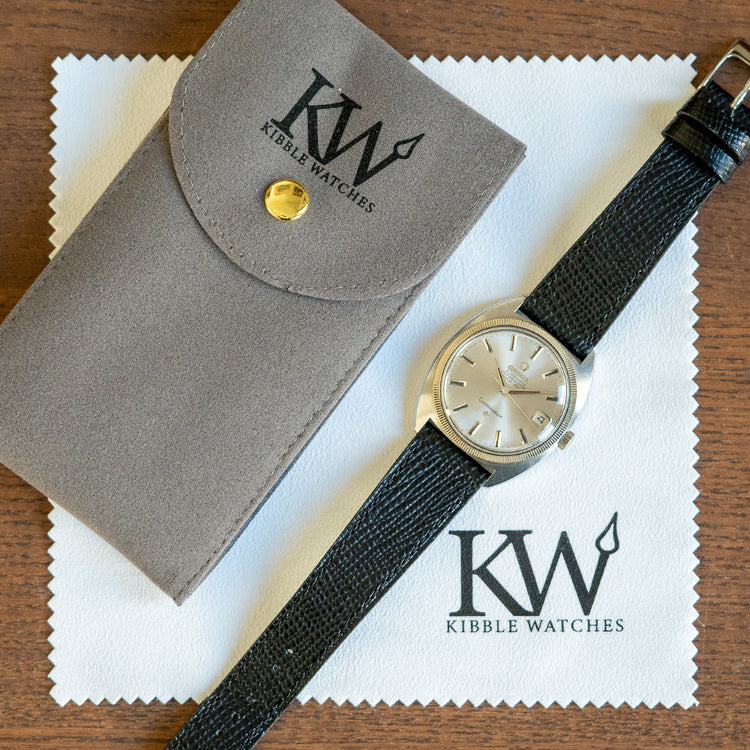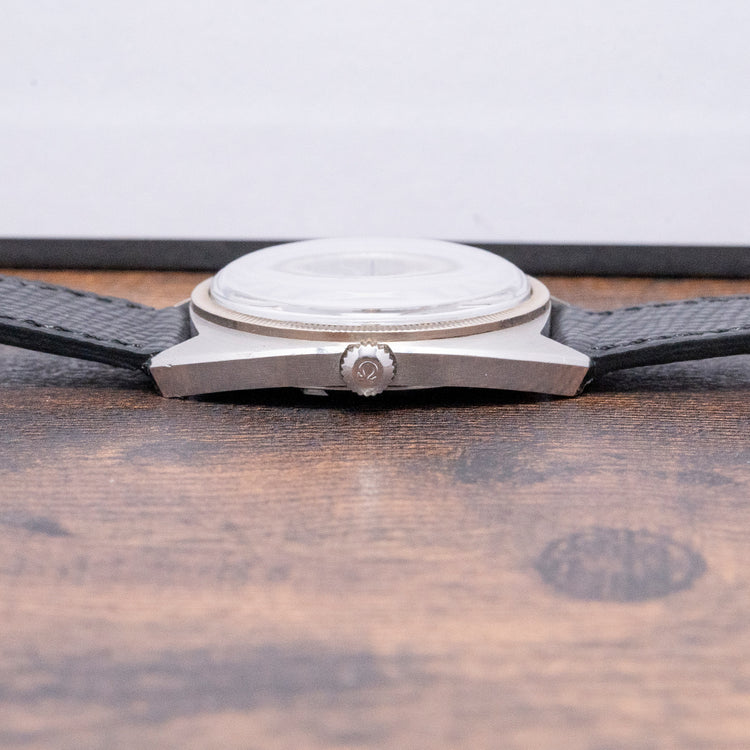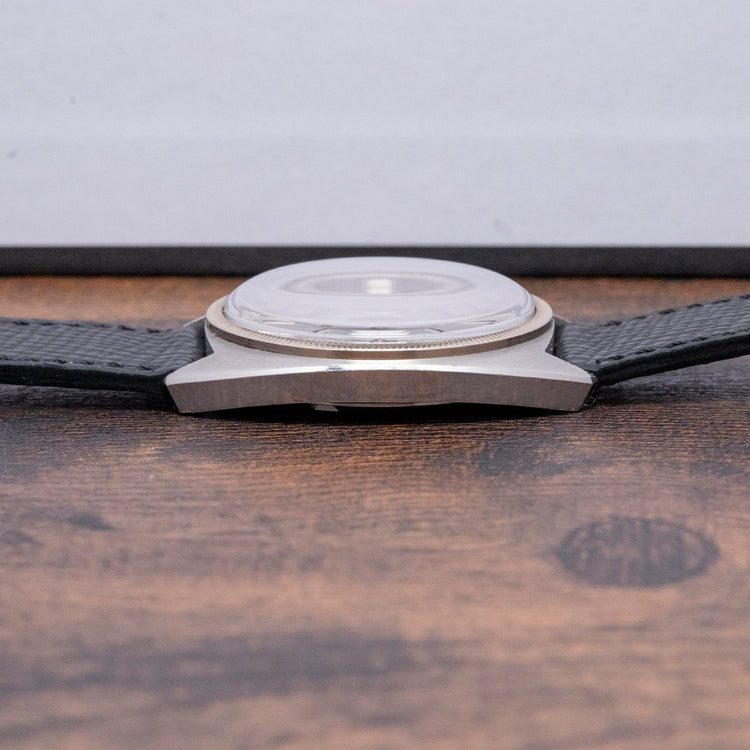More Information
Description
More
Less
The Watch
Here we have a 1968 Omega Constellation C-Case 168.027 with a satin-brushed and polished 34.5mm stainless steel C-shaped case comfortably sitting on your wrist like a cushion. Omega first introduced the Constellation in 1952, at the time it was Omega's flagship timepiece, the first models had a Cal. 354 bumper movement in them. Later in 1955, Omega introduced the Automatic Cal. 50x, followed in 1959 by the Cal.55x (no date) and 56x (date) versions. Many of the Constellations came with pie-pan dials, diamond indexes, and fancy lug configurations, and all the gold Constellations of that time had the Observatory of Geneva's hand engraved on the back. The stainless steel and stainless steel/gold versions had a gold medallion on the back with the Observatory of Geneva, the eight stars above the Observatory stand for the many exploits of Omega in the world Chronometer competition, celebrating the fact that all Constellations are Chronometer Certified. In 1964, Omega introduced its first Constellation with the “C” case, due to the case resembling two mirrored Cs, the “C” case was a modern move away from the popular round Constellations of the 1950s. The curvaceous flanks have a polished bevel edge leading to a lug-to-lug length of 40.5mm and a case thickness of 10mm ensuring a comfortable fit on your wrist. An attractive slim white gold fluted bezel holds the domed crystal above a silver dial with an outer minute track surrounding applied chamfered edge baton indexes, that play with the light as you rotate your wrist. At 3 o’clock a framed date window. Slender Dauphine hands are complemented with a tapered centre second hand. At 12 o’clock an applied Omega and “Automatic Chronometer Officially Certified” printed in black. Below at 6 o'clock “Constellation” and an applied star completes this sophisticated dress watch. On the reverse a screw-down case back with an embossed Observatory and eight stars, inside an automatic Omega Cal. 564, 24 jewels, 19,800 beats per hour. The watch comes paired with a suitable 19mm leather strap and a pin buckle.
Points of Mention
This watch is sold “Watch Only” and therefore without its Omega box and paperwork. The watch comes paired with a suitable 19mm leather strap and a pin buckle. The watch is from Circa. 1968 and is sold in worn vintage condition, but overall fair condition as you can see. The watch comes with our 12-Months NON-Waterproof Warranty.
For more photos see here - https://drive.google.com/drive/folders/1qInGzwJnN9Z68g4qf9L3gjxUGFOdV7cq?usp=drive_link
4K YouTube video, skip to 22:03 - https://youtu.be/MioyQakc4oU
Personal Note
This 1968 Omega Constellation "C-Case" featuring a white gold bezel is truly beautiful and something to see for yourself, so don't hesitate to book an appointment! The case shape makes this 34.5mm case wear much larger and appear much larger on the wrist, the simple but elegant tones of the dial contrast perfectly against the subtle warmer tone of the bezel... It's clean and it's classic, and that is what vintage Omega is all about.
Specification
Lugs : 19mm
Condition : Pre-Owned
Box & Papers : None
Case Material : Stainless Steel
Warranty : 12-Months NON-Waterproof Warranty
The Brand
Formerly known as the La Generale Watch Co. in 1848 founded by Louis Brandt in La Chaux-de-Fonds. When he died in 1879, his sons carried on his dream. In 1880 they moved to 96 Rue Jakob-Stampfli where they remain today. The brothers produced their first mass-produced calibre, the Labrador In 1885. Just a few years later in 1892, they produced the first minute-repeater. In 1903 they renamed the company Omega until 1982 when they officially changed their name to Omega SA. During WW1 Omega watches were used as official timekeepers for the Royal Flying Corps and the US Army. In 1930, Omega and Tissot merged together to form Société Suisse pour l'Industrie Horlogère (SSIH) In 1931, another group was formed - Allgemeine Schweizerische Uhrenindustrie AG (ASUAG). Where SSIH was primarily French-speaking, ASUAG was founded by the more German-speaking members of the Swiss watch industry. In 1948 they introduced the first edition of one of its most symbolic watches: the Seamaster. Omega first introduced the Constellation in 1952. At the time it was Omega's flagship timepiece. The first models had a Cal. 354 bumper movement in them. Later in 1955, Omega introduced the Automatic Cal. 50x, followed in 1959 by the Cal.55x (no date) and 56x (date) versions. Many of the Constellations came with pie-pan dials, diamond indexes, and fancy lug configurations. All the gold Constellations of that time have the Observatory of Geneva's hand engraved on the back. The stainless steel and stainless steel/gold versions had a gold medallion on the back with the Observatory of Geneva. The eight stars above the Observatory stand for the many exploits of Omega in the world Chronometer competition. Celebrating the fact that all Constellations are Chronometer Certified. In 1962, when astronaut Wally Schirra wore a Speedmaster on his Mercury Sigma 7 Mission, making it the first Omega watch to enter space. After rigorous tests, NASA used Omega for all their Apollo missions including the 1969 Moon landing of Apollo 11. Today Omega is still an astronaut's first choice. In 1969, President Nixon famously said it was “too valuable” and turned down the first-ever all-gold Speedmaster Professional Deluxe. As a response to the ever-growing threat of electronic watches to the manufacturers of mechanical watches, Omega and many Swiss brands such as Rolex and Patek Philippe formed Centre Electronique Horologer (CEH). Prototypes began to appear in 1967 with their production starting in 1968. Then In 1972, Omega introduced the reference, 198.030, which included the Omega calibre 1250, a ‘tuning-fork electronic movement which was made under licence from Bulova. Later we saw a merger of SSIH and ASUAG into SMH, or Société de Microélectronique et d’Horlogerie. This merger took place in 1983. In 1992, the company acquired Blancpain, and in 1998 it officially rebranded itself from SMH to the Swatch Group. Then, in 1999, they purchased and integrated Breguet into the Swatch Group.
Points of Mention
More
Less
Personal Note
More
Less
Specification
More
Less
Movement : Automatic Omega Cal. 564
Year : 1968
Case Size : 40mm
Case Thickness : 10 mm
Lug to Lug : 40.5mm
Lugs : 19mm
Condition : Pre-Owned
Box and Papers : None
Case Material : Stainless Steel
Warranty : 12-Months NON-Waterproof Warranty
The wrist model's wrist size is 7inch
About Baltic
More
Less
Description
The Watch
Here we have a 1968 Omega Constellation C-Case 168.027 with a satin-brushed and polished 34.5mm stainless steel C-shaped case comfortably sitting on your wrist like a cushion. Omega first introduced the Constellation in 1952, at the time it was Omega's flagship timepiece, the first models had a Cal. 354 bumper movement in them. Later in 1955, Omega introduced the Automatic Cal. 50x, followed in 1959 by the Cal.55x (no date) and 56x (date) versions. Many of the Constellations came with pie-pan dials, diamond indexes, and fancy lug configurations, and all the gold Constellations of that time had the Observatory of Geneva's hand engraved on the back. The stainless steel and stainless steel/gold versions had a gold medallion on the back with the Observatory of Geneva, the eight stars above the Observatory stand for the many exploits of Omega in the world Chronometer competition, celebrating the fact that all Constellations are Chronometer Certified. In 1964, Omega introduced its first Constellation with the “C” case, due to the case resembling two mirrored Cs, the “C” case was a modern move away from the popular round Constellations of the 1950s. The curvaceous flanks have a polished bevel edge leading to a lug-to-lug length of 40.5mm and a case thickness of 10mm ensuring a comfortable fit on your wrist. An attractive slim white gold fluted bezel holds the domed crystal above a silver dial with an outer minute track surrounding applied chamfered edge baton indexes, that play with the light as you rotate your wrist. At 3 o’clock a framed date window. Slender Dauphine hands are complemented with a tapered centre second hand. At 12 o’clock an applied Omega and “Automatic Chronometer Officially Certified” printed in black. Below at 6 o'clock “Constellation” and an applied star completes this sophisticated dress watch. On the reverse a screw-down case back with an embossed Observatory and eight stars, inside an automatic Omega Cal. 564, 24 jewels, 19,800 beats per hour. The watch comes paired with a suitable 19mm leather strap and a pin buckle.
Points of Mention
This watch is sold “Watch Only” and therefore without its Omega box and paperwork. The watch comes paired with a suitable 19mm leather strap and a pin buckle. The watch is from Circa. 1968 and is sold in worn vintage condition, but overall fair condition as you can see. The watch comes with our 12-Months NON-Waterproof Warranty.
For more photos see here - https://drive.google.com/drive/folders/1qInGzwJnN9Z68g4qf9L3gjxUGFOdV7cq?usp=drive_link
4K YouTube video, skip to 22:03 - https://youtu.be/MioyQakc4oU
Personal Note
This 1968 Omega Constellation "C-Case" featuring a white gold bezel is truly beautiful and something to see for yourself, so don't hesitate to book an appointment! The case shape makes this 34.5mm case wear much larger and appear much larger on the wrist, the simple but elegant tones of the dial contrast perfectly against the subtle warmer tone of the bezel... It's clean and it's classic, and that is what vintage Omega is all about.
Specification
Lugs : 19mm
Condition : Pre-Owned
Box & Papers : None
Case Material : Stainless Steel
Warranty : 12-Months NON-Waterproof Warranty
The Brand
Formerly known as the La Generale Watch Co. in 1848 founded by Louis Brandt in La Chaux-de-Fonds. When he died in 1879, his sons carried on his dream. In 1880 they moved to 96 Rue Jakob-Stampfli where they remain today. The brothers produced their first mass-produced calibre, the Labrador In 1885. Just a few years later in 1892, they produced the first minute-repeater. In 1903 they renamed the company Omega until 1982 when they officially changed their name to Omega SA. During WW1 Omega watches were used as official timekeepers for the Royal Flying Corps and the US Army. In 1930, Omega and Tissot merged together to form Société Suisse pour l'Industrie Horlogère (SSIH) In 1931, another group was formed - Allgemeine Schweizerische Uhrenindustrie AG (ASUAG). Where SSIH was primarily French-speaking, ASUAG was founded by the more German-speaking members of the Swiss watch industry. In 1948 they introduced the first edition of one of its most symbolic watches: the Seamaster. Omega first introduced the Constellation in 1952. At the time it was Omega's flagship timepiece. The first models had a Cal. 354 bumper movement in them. Later in 1955, Omega introduced the Automatic Cal. 50x, followed in 1959 by the Cal.55x (no date) and 56x (date) versions. Many of the Constellations came with pie-pan dials, diamond indexes, and fancy lug configurations. All the gold Constellations of that time have the Observatory of Geneva's hand engraved on the back. The stainless steel and stainless steel/gold versions had a gold medallion on the back with the Observatory of Geneva. The eight stars above the Observatory stand for the many exploits of Omega in the world Chronometer competition. Celebrating the fact that all Constellations are Chronometer Certified. In 1962, when astronaut Wally Schirra wore a Speedmaster on his Mercury Sigma 7 Mission, making it the first Omega watch to enter space. After rigorous tests, NASA used Omega for all their Apollo missions including the 1969 Moon landing of Apollo 11. Today Omega is still an astronaut's first choice. In 1969, President Nixon famously said it was “too valuable” and turned down the first-ever all-gold Speedmaster Professional Deluxe. As a response to the ever-growing threat of electronic watches to the manufacturers of mechanical watches, Omega and many Swiss brands such as Rolex and Patek Philippe formed Centre Electronique Horologer (CEH). Prototypes began to appear in 1967 with their production starting in 1968. Then In 1972, Omega introduced the reference, 198.030, which included the Omega calibre 1250, a ‘tuning-fork electronic movement which was made under licence from Bulova. Later we saw a merger of SSIH and ASUAG into SMH, or Société de Microélectronique et d’Horlogerie. This merger took place in 1983. In 1992, the company acquired Blancpain, and in 1998 it officially rebranded itself from SMH to the Swatch Group. Then, in 1999, they purchased and integrated Breguet into the Swatch Group.
Points of Mention
Personal Note
Specification
The Brand
Enquire or Book an Appointment
Would you like to discover further details about this watch, or perhaps arrange an appointment to view and try it on? Complete this form and a member of our team will get back to you shortly.
You May Also Like




















